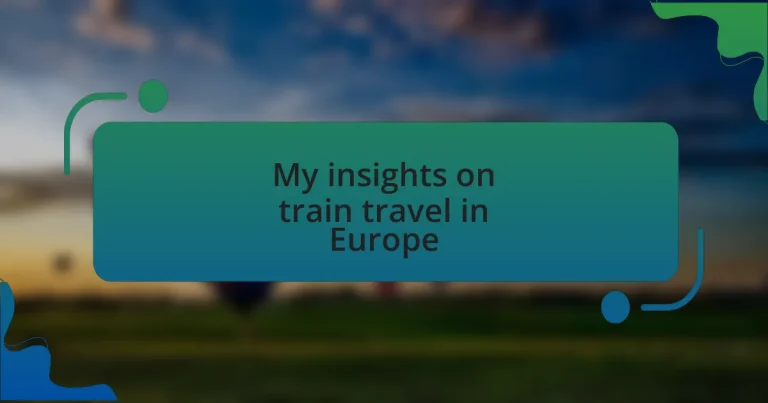Key takeaways:
- Train travel offers unique advantages such as scenic views, comfort, and community amongst travelers.
- Popular European routes include the Eurostar from London to Paris, the Venice to Milan journey, and the Glacier Express in Switzerland.
- Booking tips emphasize checking multiple platforms for ticket prices, planning ahead for deals, and understanding ticket types.
- Challenges in train travel include navigating schedules, technology discrepancies, and cultural etiquette, which can lead to personal growth and adaptability.
Author: Evelyn Hartley
Bio: Evelyn Hartley is a bestselling author known for her compelling historical novels that delve into the complexities of human relationships. With a background in literature and a passion for storytelling, she crafts richly detailed narratives that transport readers to different eras. Her award-winning debut novel, “Whispers of the Past,” was praised for its vivid characters and intricate plots. When she’s not writing, Evelyn enjoys exploring antique shops and researching the fascinating stories behind forgotten artifacts. She resides in a charming cottage in Vermont, where she draws inspiration from the beauty of nature and the stories it holds.
Benefits of train travel
One of the biggest advantages of train travel is the opportunity to take in stunning landscapes as they unfold outside your window. I remember a ride through the Swiss Alps, where the mountains towered majestically, and the views were nothing short of breathtaking. Isn’t it amazing how the journey itself can become a memorable part of your adventure?
Another benefit is the comfort and space trains often provide compared to planes or buses. I’ve found that I can stretch out, walk around, and even grab a bite at the dining car without the hassle of security lines. How often do you get to relax while traveling, free from the rush and stress of an airport?
Additionally, train travel fosters a unique sense of community among travelers. On a trip from Paris to Berlin, I struck up a conversation with a fellow passenger who shared fascinating stories of her travels. Isn’t it inspiring how a simple train journey can lead to connections that bring the experience to life?
Popular train routes in Europe
One iconic route that stands out is the Eurostar from London to Paris. The ride through the Channel Tunnel is an experience in itself, but it isn’t until you emerge in Gare du Nord that the excitement really kicks in. I still recall stepping off the train and feeling an exhilarating rush as I caught my first glimpse of the Eiffel Tower.
Another favorite of mine is the scenic journey from Venice to Milan. As the train glides past shimmering lakes and charming towns, I often find myself lost in thought, reflecting on the beauty of Italian culture. How often does a simple train ride evoke such admiration for the places we visit?
Lastly, the Glacier Express between Zermatt and St. Moritz deserves a special mention. This is not just a train ride; it’s a breathtaking adventure through the Swiss heartland. I vividly remember sipping hot chocolate while marveling at snow-capped peaks outside. Isn’t it incredible how trains can immerse us in such stunning natural beauty?
Tips for booking train tickets
When it comes to booking train tickets in Europe, I always recommend checking out multiple platforms. I’ve often found that fares can vary widely, depending on where you look. Websites like GoEuro or RailEurope can provide great overviews, but sometimes I stumble upon better prices directly on the railway company’s site. Have you ever punched in the same route and marveled at the price differences?
Timing is another crucial factor. Booking well in advance often secures lower prices, but I’ve also scored fantastic last-minute deals during off-peak times. I remember snagging a ticket from Barcelona to Madrid just a day before departure at a surprisingly low rate. What’s your strategy—are you a planner or a spontaneous traveler?
Don’t overlook the importance of understanding the ticket types! For instance, first-class tickets offer more comfort but might not always be necessary for shorter trips. When I took a quick journey from Prague to Vienna, I opted for second class and still enjoyed a pleasant ride, made even more enjoyable by friendly fellow travelers. It kept me wondering: do we sometimes overthink our choices instead of just enjoying the journey?
My favorite train experiences
I have had some unforgettable train experiences that truly captured the essence of traveling through Europe. One standout journey was my ride from Paris to Nice, where I was treated to breathtaking views of the French countryside. As the train snaked along the coastline, I couldn’t help but feel inspired by the vibrant colors of the Mediterranean; it was a moment where every worry faded away, and I was completely present.
Another memorable trip was the overnight train from Vienna to Venice. I remember feeling a mix of excitement and nervousness as I settled into my sleeper compartment. It was the gentle rocking of the train that lulled me to sleep, and I woke up to the enchanting sights of Italy. The thrill of waking up in a new city, with the anticipation of exploring its streets, is something that never gets old.
Traveling by train often leads to unexpected conversations with fellow passengers. On my journey from Amsterdam to Berlin, I chatted with a local artist who shared her thoughts on the city’s culture and history. That exchange not only enriched my understanding of Berlin but also reminded me how train travel can create spontaneous connections with strangers who turn into friends, even if just for a moment. How many stories are hidden within the carriages we travel?
Challenges encountered during train travel
One of the biggest challenges I faced during train travel in Europe was navigating the intricate web of schedules and connections. There was a time when I found myself running through Paris’s Gare de Lyon, desperately trying to make my transfer. The sheer size of the station can be overwhelming, especially when you’re lugging heavy bags and trying to decipher that complex network of signs. It made me appreciate the importance of planning ahead and allowing extra time between connections.
Downloading the right apps became a lifeline on my travels, but even technology has its limits. I encountered several instances where real-time updates didn’t match what I saw in the stations. I’ll never forget the wave of panic I felt when my train to Barcelona was delayed, and I witnessed fellow travelers scrambling to adjust their plans. It’s a reminder that flexibility is essential; when things go awry, it can lead to unexpected adventures—or misadventures.
Another challenge is dealing with different cultures and etiquette across countries. I once boarded a train in Italy, only to realize my reserved seat was already occupied by a man deep into his novel. Instead of creating a scene, I decided to take it in stride, finding a spare seat elsewhere. Moments like these can lead to awkwardness or frustration, but they also push me out of my comfort zone and teach valuable lessons about patience and adaptability. Isn’t it fascinating how travel challenges can foster personal growth?




